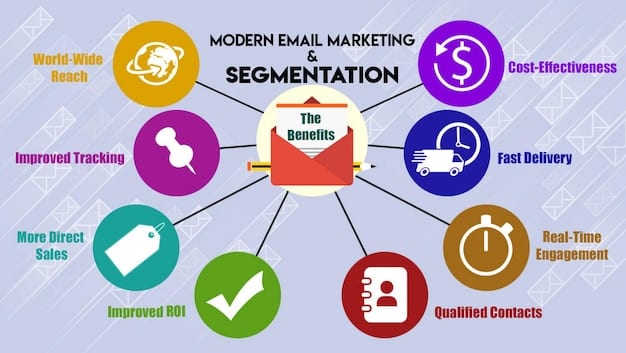The Ultimate Guide to Digital Marketing Analytics: Boost Performance by 12%

The Ultimate Guide to Digital Marketing Analytics: Track, Measure, and Optimize for a 12% Improvement provides a comprehensive framework for leveraging data to refine strategies, enhance customer engagement, and drive tangible improvements in ROI. Master analytics to improve marketing outcomes.
In today’s competitive digital landscape, simply having a presence isn’t enough. You need to understand how your efforts are performing, identify areas for improvement, and optimize your strategies for maximum impact. That’s where The Ultimate Guide to Digital Marketing Analytics: Track, Measure, and Optimize for a 12% Improvement comes in.
This guide aims to equip you with the knowledge and tools necessary to transform your marketing data into actionable insights, leading to a tangible 12% improvement in your digital marketing performance. Ready to dive in?
Understanding the Fundamentals of Digital Marketing Analytics
Before diving into specific tools and techniques, it’s crucial to grasp the fundamental principles of digital marketing analytics. This involves understanding key metrics, defining your goals, and setting up a proper tracking infrastructure. The Ultimate Guide to Digital Marketing Analytics: Track, Measure, and Optimize for a 12% Improvement begins with the basics.
Key Metrics to Track
Identifying the right metrics is essential for measuring the success of your digital marketing campaigns. Here are a few key metrics to consider:
- Website Traffic: The number of visitors to your website, including unique visitors and page views.
- Conversion Rate: The percentage of visitors who complete a desired action, such as making a purchase or filling out a form.
- Customer Acquisition Cost (CAC): The total cost of acquiring a new customer.
- Return on Ad Spend (ROAS): The amount of revenue generated for every dollar spent on advertising.
These metrics provide a starting point for your analysis. Tailor your tracking to align with your specific business objectives to truly capitalize on The Ultimate Guide to Digital Marketing Analytics: Track, Measure, and Optimize for a 12% Improvement.
Setting Clear Goals and Objectives
Without clearly defined goals, it’s impossible to measure the effectiveness of your digital marketing efforts. Start by identifying your primary business objectives and then translating them into specific, measurable, achievable, relevant, and time-bound (SMART) goals. For example, instead of “increase website traffic,” aim for “increase website traffic by 20% in the next quarter.”
Understanding these metrics will allow you to capitalize on the knowledge in The Ultimate Guide to Digital Marketing Analytics: Track, Measure, and Optimize for a 12% Improvement to improve your website.

Leveraging Google Analytics for Data-Driven Decisions
Google Analytics is a powerful and free tool that provides valuable insights into your website’s performance. By mastering Google Analytics, you can gain a deeper understanding of your audience, identify areas for improvement, and optimize your website for increased conversions.
Setting Up Goals in Google Analytics
Defining goals in Google Analytics allows you to track specific actions that are important to your business, such as form submissions, product purchases, or video views. By setting up goals, you can measure your conversion rate and identify areas where you can improve the user experience. This is an essential part of The Ultimate Guide to Digital Marketing Analytics: Track, Measure, and Optimize for a 12% Improvement.
Analyzing Key Reports
Google Analytics offers a wide range of reports that provide valuable insights into your website’s performance. Some key reports to analyze include:
- Audience Overview: Provides a high-level overview of your website’s traffic, including demographics, interests, and behavior.
- Acquisition Reports: Shows how visitors are finding your website, including organic search, paid advertising, and social media.
- Behavior Reports: Reveals how visitors are interacting with your website, including page views, bounce rate, and time on site.
- Conversion Reports: Tracks the completion of your defined goals, providing insights into your conversion rate and revenue.
Harnessing Social Media Analytics for Enhanced Engagement
Social media has become an integral part of most digital marketing strategies. Platforms like Facebook, Instagram, and Twitter offer built-in analytics tools that provide valuable insights into your audience, content performance, and overall engagement. This is why social media features heavily in The Ultimate Guide to Digital Marketing Analytics: Track, Measure, and Optimize for a 12% Improvement.
Tracking Key Social Media Metrics
Monitoring the right social media metrics is crucial for measuring the success of your social media campaigns. Key metrics to track include:
- Reach: The number of unique users who saw your content.
- Engagement: The number of interactions with your content, including likes, comments, and shares.
- Click-Through Rate (CTR): The percentage of users who clicked on a link in your social media post.
- Conversion Rate: The percentage of users who completed a desired action after clicking on a link in your social media post.
Using Social Listening Tools
Social listening tools allow you to monitor conversations about your brand, industry, and competitors across social media platforms. These tools can provide valuable insights into customer sentiment, trending topics, and potential opportunities for engagement. Successfully actioning feedback from social listening will allow you to truly master The Ultimate Guide to Digital Marketing Analytics: Track, Measure, and Optimize for a 12% Improvement.
By understanding how to use these tools, you can proactively address customer concerns, identify new product ideas, and stay ahead of the competition.
Optimizing Email Marketing Campaigns with Analytics
Email marketing remains a highly effective channel for reaching your audience and driving conversions. By analyzing the performance of your email campaigns, you can identify areas for improvement and optimize your strategy for maximum impact. Every step of the way, The Ultimate Guide to Digital Marketing Analytics: Track, Measure, and Optimize for a 12% Improvement is here to help.
Key Email Marketing Metrics to Track
Tracking the right email marketing metrics is essential for measuring the success of your campaigns. Important metrics include:
- Open Rate: The percentage of recipients who opened your email.
- Click-Through Rate (CTR): The percentage of recipients who clicked on a link in your email.
- Conversion Rate: The percentage of recipients who completed a desired action after clicking on a link in your email.
- Bounce Rate: The percentage of emails that could not be delivered.
A/B Testing for Email Optimization
A/B testing involves testing different versions of your email campaigns to see which performs better. You can A/B test various elements, such as subject lines, email copy, calls to action, and images. These are valuable exercises in The Ultimate Guide to Digital Marketing Analytics: Track, Measure, and Optimize for a 12% Improvement and should be carried out frequently.
By analyzing the results of your A/B tests, you can identify the most effective strategies for maximizing your email marketing performance.

Turning Data into Actionable Insights
Collecting and analyzing data is only half the battle. The real value lies in turning that data into actionable insights that drive meaningful improvements in your digital marketing performance. When it all comes together, you see the magic of The Ultimate Guide to Digital Marketing Analytics: Track, Measure, and Optimize for a 12% Improvement.
Identifying Trends and Patterns
By analyzing your data over time, you can identify trends and patterns that provide valuable insights into your audience’s behavior and preferences. For example, you might discover that certain types of content resonate more with your audience or that certain marketing channels are more effective at driving conversions.
Creating Data-Driven Strategies
Once you’ve identified key trends and patterns, you can develop data-driven strategies to optimize your digital marketing campaigns. This might involve adjusting your content strategy, refining your targeting, or reallocating your budget to more effective channels. Let The Ultimate Guide to Digital Marketing Analytics: Track, Measure, and Optimize for a 12% Improvement take the lead as you learn to extract clear signals from the noise.
By continuously monitoring your data and making adjustments based on your findings, you can ensure that your digital marketing efforts are always aligned with your business objectives. This continuous effort ties directly into The Ultimate Guide to Digital Marketing Analytics: Track, Measure, and Optimize for a 12% Improvement.
In conclusion, mastering digital marketing analytics is essential for success in today’s competitive landscape.
| Key Point | Brief Description |
|---|---|
| 📊 Metric Tracking | Identify and monitor key performance indicators (KPIs). |
| 🎯 Goal Setting | Define clear and measurable objectives for campaigns. |
| 📈 Optimization | Fine-tune strategies based on data analysis. |
| 📣 Social Listening | Monitor brand mentions and industry trends on social platforms. |
Frequently Asked Questions
Digital marketing analytics involves collecting and analyzing data to measure the effectiveness of marketing campaigns. It’s crucial for understanding customer behavior and optimizing strategies for better results. The Ultimate Guide to Digital Marketing Analytics: Track, Measure, and Optimize for a 12% Improvement can help you do this.
Popular tools include Google Analytics, social media analytics dashboards (like Facebook Insights), and email marketing platforms (such as Mailchimp). Each provides unique insights into different facets of your digital presence.
Analyze open rates, click-through rates, and conversion rates to identify what resonates with your audience. Use A/B testing to optimize subject lines, content, and calls-to-action. The Ultimate Guide to Digital Marketing Analytics: Track, Measure, and Optimize for a 12% Improvement will help you understand your consumer base to a deeper degree.
A/B testing involves comparing two versions of a marketing asset to see which performs better. It helps you make data-driven decisions and optimize your campaigns for higher engagement and conversions.
By providing a structured approach to data analysis, goal setting, and strategy optimization, following The Ultimate Guide to Digital Marketing Analytics: Track, Measure, and Optimize for a 12% Improvement will give you the means to make informed decisions, refine your techniques based on actual results, and significantly improve ROI.
Conclusion
By embracing digital marketing analytics, you can gain a competitive edge, enhance customer engagement, and drive meaningful improvements in your bottom line. The Ultimate Guide to Digital Marketing Analytics: Track, Measure, and Optimize for a 12% Improvement is only the first step for you. Don’t be afraid to experiment and optimize!
By implementing the strategies outlined in this guide, you can unlock the full potential of your digital marketing efforts and achieve a tangible 12% improvement in your performance. Ready to transform your marketing data into actionable insights?





